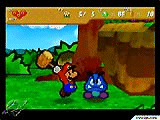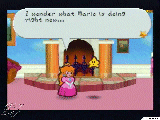

Paper Mario
Stats:
System: Nintendo 64
Release Year: 2001
Publisher: Nintendo
Developer: Intelligent Systems
Players: 1
ESRB: E
Plot
Wow. For a Mario game, this is fairly thought out. Instead of the usual Bowser-steal-princess-Mario-rescue plot we’ve seen rehashed all too many times over the years, the big brute shows a glimmer of intelligence. Before attempting to capture the princess, he goes up to Star road, (apparently rebuilt and filled with actual living things since MRPG) and steals the star rod (which I guess is on loan from Pop star). He uses the immense power to imprison the star spirits in cards and deposit them in the seven corners of Mushroom Kingdom. Meanwhile, Mario and Luigi are both invited to a party and Peach’s castle. Once there, Mario and Peach get a moment alone near the balcony where they hope to share a sweet thought or two. Right at that moment, Bowser’s fortress actually comes out of the ground and lifts Peach’s a couple miles into the air. With the power of the star rod, Bowser is able to beat Mario for the very first time, boot him out of the castle where he lands in the forest lucky to have all his organs he’s so beaten. A small Goomba boy finds him and the town he lives in cares him for a couple days for him to recover. Once he’s back on his feet, he is informed with the situation of the Star Spirits, and so he starts his quest to get them back and stop Bowser.
Overview
The game doesn’t have the best feel to it, with the obvious cartoony-looking characters and settings, the drab music, and the recycled personalities. With that said, Paper Mario is one of the most in-depth games around. It’s much like a Mario’s Majora’s Mask. It’s just as fast to complete, there are just as many people’s lives you can affect. Fans of Princess Peach may now rejoice. In between the main part of the game with Mario, you get to play as Peach for a short time as she creeps through the castle trying to find info for Mario and generally cause mischief, a bold step for the former damsel in distress. The battle sequences aren’t horrid, but they need some improvements. The actual battling isn’t too bad. Mario gets an assortment of badges during his travels, giving him special abilities. Certain enemies need certain attacks, and the requirements are more in depth than the original. I will say that every point value in battle is tiny, which is a little unsettling to RPG lovers. Any attack that reaches over 10 is considered a doomsday attack.
Many elements in this game were taken from MRPG, which is mostly what makes it so good. Instead of four other party members, though, you get a whopping eight. You can pick one to follow you around on screen, and when doing so they each have one special ability. Watt, a light bulb character, for example, can light up dark rooms. They also have their own battle strengths and weaknesses. Watt can easily cut through the toughest defenses but isn’t too strong. The side quests are long, involving you to go all over the place, and then end up doing nothing but getting you a badge. Ugh. The “side quest” I found most entertaining was by far Tayce T. If you run into her in a house in toad town look into it. Especially after you find her cookbook. It’s oodles of fun.
While most people will say that Gameplay is more important than how a game feels or looks, this would be a good game for you to discuss. It has sacrificed totally graphics, music, and overall personality of the characters for a very in depth game that’s easy to beat but nearly impossible to find everything hidden. While most people think this is good, I for one believe that it is practiced to the extreme. I still say it’s the second best Mario game, with the best being MRPG.

